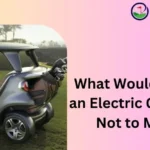Gas golf cart problems can include issues with the ignition switch, motor, accelerator, carburetor, and fuel delivery.
Some common problems can include a non-working accelerator, a sticking accelerator pedal, a faulty accelerator potentiometer, and fuel delivery issues.
Ignition wiring may become loose and require replacement due to wear and tear. In addition, low-charge or flat batteries, loose or corroded battery terminals, faulty wire connections, and blown fuses can also cause problems.
It’s important to troubleshoot these issues to keep your gas golf cart running smoothly. Do you know, What is the gas golf cart problems?
Electric golf carts are an alternative option that are quieter, require less maintenance, and produce zero emissions for the environment.
However, gas golf carts have their advantages in terms of speed and power. Overall, choosing between gas and electric golf carts depends on individual preferences and needs.
What Are The Common Problems With Club Car Gas Golf Cart?
Gas golf carts are popular among golfers and recreational users for their convenience and ease of use. However, like any other machinery, gas golf carts can experience problems that may prevent them from running smoothly.
Understanding these problems and their causes can help you diagnose and address issues quickly, ensuring that your golf cart is always in top shape.
In this article, we will explore some common problems with gas golf carts and discuss the possible causes behind these malfunctions:
a. Common Problems With Gas Golf Carts
Gas golf carts can encounter several common problems that may hinder their performance.
Here are some of the most frequently observed issues:
- The engine cranks but the cart doesn’t start
- Lack of power or sluggish acceleration
- Excessive smoke or unusual odor
- Jerky or erratic movement
- Leaking fluids
- Dead battery
- Causes Of Gas Golf Cart Malfunctions
Now that we know the common problems, let’s delve into the potential causes that can lead to gas golf cart malfunctions:
Fuel system issues: Problems with the fuel system, such as a clogged fuel filter or carburetor, can prevent proper fuel flow and result in starting issues or lack of power.
Ignition system faults: Faulty spark plugs, ignition coils, or spark plug wires can cause the engine to misfire or fail to start, leading to poor performance.
Electrical problems: Loose or corroded electrical connections, faulty wiring, or a malfunctioning solenoid can disrupt the electric current flow and affect various components, resulting in cart malfunctions.
Transmission troubles: Issues with the clutch, belts, or gears can cause jerky or erratic movement, affecting the cart’s overall performance.
b. Engine maintenance neglect
Failure to perform regular maintenance tasks, such as changing the oil, cleaning the air filter, or adjusting the valves, can lead to engine problems and poor performance.
By understanding the common problems and their potential causes, you can effectively troubleshoot and address issues with your gas golf cart.
Regular maintenance, timely repairs, and proper usage can go a long way in ensuring a smooth and enjoyable golf cart experience.
c. Solutions For Gas Golf Cart Issues
If you own a gas golf cart, you may encounter some common problems along the way. From starting issues to engine troubles, these issues can be frustrating and hinder your golf cart’s performance.
However, there are solutions available that can help you troubleshoot and resolve these problems. In this article, we will discuss some common gas golf cart problems and provide you with effective solutions.
Why won’t my golf cart start?
When it comes to troubleshooting gas golf carts, it is important to identify the root cause of the problem.

Here are some common issues and their possible solutions:
1. Cranks but Won’t Run
If your gas golf cart cranks but won’t run, the easiest fix is to check the fuel supply. Ensure that the gas tank has enough fuel and that the fuel lines are not clogged. Additionally, inspect the fuel filter and clean or replace it if necessary.
2. Starting Problems
If your golf cart is having trouble starting, the battery may be the culprit. Start by checking the battery’s charge and connections.
If the battery is faulty, replace it. In some cases, the starter generator or solenoid may also need to be inspected or replaced.
3. Engine Troubles
In the case of engine troubles, a few maintenance tips can go a long way. Inspect the engine for any visible issues, such as loose or damaged wires.
Repair or replace any damaged parts accordingly. It is also essential to regularly change the engine oil and keep it within acceptable limits to ensure optimal performance.
Maintenance Tips For Gas Golf Carts
To prevent gas golf cart issues and ensure smooth operation, regular maintenance is key.
Here are a few maintenance tips to keep in mind:
- Clean and torque all leads and connections to prevent loose connections.
- Charge the battery regularly or replace it if it is faulty.
- Inspect and replace any leads or connections that show signs of wear or damage.
- Regularly inspect the engine for any visible issues and carry out necessary repairs.
- Check the oil level regularly and drain it to acceptable limits to maintain proper lubrication.
By following these maintenance tips and troubleshooting gas golf cart problems effectively, you can keep your golf cart performing at its best.
Remember to prioritize regular maintenance and address any issues promptly to ensure a great golfing experience. Take care of your gas golf cart, and it will continue to serve you well for years to come.
What is the gas golf cart problems?
When it comes to choosing between gas and electric golf carts, several factors need to be considered to make the right decision.
Let’s delve into the key aspects of durability and longevity, as well as the performance and environmental impact of these two types of golf carts:
1. Durability And Longevity
Gas golf carts are known for their robust construction and durability, making them ideal for rugged terrains and heavy-duty use.
The engines in gas golf carts are designed to withstand prolonged operation, ensuring longevity and reliability even in challenging conditions.
On the other hand, electric golf carts have fewer moving parts, leading to lower maintenance requirements and potentially longer lifespan.
2. Performance And Environmental Impact
Gas golf carts offer powerful performance, especially when climbing steep hills or navigating uneven terrains.
However, they produce emissions during operation, contributing to environmental pollution. In contrast, electric golf carts are quieter and produce zero emissions, making them environmentally friendly options.
Although electric carts may have slightly lower power, their eco-friendly nature makes them a preferred choice for many golf cart users.
3. Tips For Troubleshooting Gas Golf Carts
Gas golf cart problems can range from issues with the ignition or motor to accelerator malfunctions and fuel delivery problems.
Troubleshooting these common problems involves checking the battery, inspecting leads and connections, and repairing or replacing faulty components as needed.
It’s important to keep the cart’s engine and oil level in good condition and address any wiring or machinery issues that may arise.
Gas golf cart bad battery symptoms
If your gas golf cart is experiencing problems, checking the fuel and ignition systems should be your first troubleshooting step.

Here are some tips:
Ensure there is enough fuel in the gas tank. If the tank is empty, fill it up with fresh gasoline.
Inspect the fuel lines for any blockages or leaks. If you notice any issues, replace or repair the affected parts.
Check the fuel filter for clogs. If it appears dirty or clogged, replace it with a new one.
Inspect the ignition system, including the spark plugs and ignition coil. Clean or replace any components that appear worn or damaged.
Test the spark plugs by removing them from the engine, grounding them to the metal surface, and cranking the engine. If you don’t see a spark, replace the spark plugs.
Ensure the battery is fully charged and properly connected to the ignition system. Clean any corrosion from the battery terminals. Inspecting Battery And Electrical Connections
The battery and electrical connections play a crucial role in the functioning of a gas golf cart. Here are some troubleshooting tips for this area:
Check the battery voltage using a multimeter. If the voltage is below the recommended level, charge or replace the battery.
Inspect the battery cables for any corrosion or loose connections. Clean the terminals and tighten any loose connections.
Examine the wiring harness for any frayed or damaged wires. Repair or replace any wires as necessary.
Test the solenoid by using a multimeter to check for continuity. If it fails the test, replace the solenoid.
Inspect the key switch and other electrical components for any signs of wear or damage. Replace any faulty parts.
How to turn on golf cart?
Regular maintenance is essential for keeping your gas golf cart running smoothly and preventing common problems.
By following a preventive maintenance routine, you can ensure that your cart stays in optimal condition, avoiding costly repairs and downtime.
Two key areas of preventive maintenance for gas golf carts include regular oil and filter changes, as well as proper battery care and maintenance:
1. Regular Oil And Filter Changes
Regular oil and filter changes are crucial for maintaining the performance and longevity of your gas golf cart’s engine.
Over time, the oil in your cart’s engine can become dirty and lose its lubricating properties, leading to increased friction and potential damage.
By replacing the oil and filter at the recommended intervals, usually every 100 hours of operation or once a year, you can ensure that your cart’s engine remains properly lubricated and prevents unnecessary wear and tear.
During an oil change, it’s important to drain the old oil completely and refill it with the correct type and amount of oil recommended by the manufacturer.
Additionally, don’t forget to replace the oil filter to prevent contaminants from circulating in the engine. Regular oil and filter changes not only improve engine performance but also extend the life of your gas golf cart.
2. Proper Battery Care And Maintenance
The battery is a crucial component of your gas golf cart, providing the necessary power to start the engine and run important electrical systems.
Proper battery care and maintenance are essential for ensuring optimal performance and avoiding battery-related problems.
One important aspect of battery care is keeping the battery terminals clean and free from corrosion. Corroded terminals can hinder the flow of electricity and affect the overall performance of the battery.
Regularly inspect the terminals and clean them with a mixture of baking soda and water if necessary. Apply a thin layer of petroleum jelly after cleaning to prevent future corrosion.
In addition to keeping the terminals clean, regularly check the water level in the battery (if applicable) and top it up with distilled water as needed. Over time, the water level in the battery can decrease due to evaporation, so it’s important to maintain the proper water level to ensure the battery’s performance.
Furthermore, when your gas golf cart is not in use for an extended period, it’s advisable to disconnect the battery to prevent it from draining completely. A fully discharged battery can lead to irreversible damage, reducing its lifespan significantly.
By following these preventive maintenance tips for your gas golf cart, you can minimize the risk of common problems and ensure a smooth and enjoyable experience on the course.
3. Review Of Gas Golf Cart Common Issues
Gas-powered golf carts are popular for their efficiency and power, but like any vehicle, they can experience common issues.
It’s essential to be aware of these problems to ensure a well-maintained and trouble-free ride. Let’s take a look at some of the common issues that gas golf cart owners may encounter.
Golf cart potentiometer problems
Gas golf carts may encounter accelerator issues, such as the pedal becoming unresponsive or sticking.
This can be caused by various factors, including cable obstructions, worn-out pedal parts, or throttle linkage problems.

Regular inspection and maintenance of the accelerator system are crucial to avoid such issues and ensure smooth operation of the golf cart:
1. Electrical And Wiring Troubles
Electrical and wiring problems are common in gas golf carts and can lead to various issues such as starting problems, lighting malfunctions, or intermittent power loss. Loose connections, corroded terminals, or damaged wiring can all contribute to electrical troubles.
Regular inspection of the electrical components and timely repairs can help prevent these issues and keep the golf cart in optimal working condition.
2. Expert Opinions On Gas Golf Cart Maintenance
When it comes to maintaining a gas golf cart, it’s essential to seek advice from experts in the field. These individuals have extensive knowledge and experience in dealing with common issues that arise with gas-powered golf carts.
By following their recommendations, you can ensure that your golf cart runs smoothly and efficiently for years to come.
Advice From Golf Cart Experts
Golf cart experts emphasize the importance of regular maintenance to avoid potential problems.
Here are a few key tips from these professionals:
Clean and torque: Regularly clean your golf cart to prevent the buildup of dirt and debris. Additionally, make sure to tighten all bolts and nuts to ensure stability.
Charge the battery or replace if faulty: Check the battery regularly and charge it as needed. If the battery is faulty, replace it promptly to avoid further issues.
Replace leads/connections: Inspect the battery leads and connections for any signs of damage or corrosion. Replace them if necessary to maintain optimal performance.
Inspect and repair the engine: Regularly inspect the engine for any signs of wear or damage. Address any issues promptly to prevent further damage and ensure the longevity of your golf cart.
Inspect oil level and drain: Check the oil level regularly and drain it to acceptable limits. This helps to maintain proper lubrication for the engine and prevent overheating. Insights From Gas Golf Cart Owners
Gas golf cart owners who have dealt with various problems also provide valuable insights.
Here are a few common issues they have encountered:
1. Ignition or motor issues
Wires in the ignition switch may become loose over time, causing the golf cart to stop running. Regular inspection and replacement of worn-out wires can prevent this problem from occurring.
In addition to expert recommendations, the choice between gas and electric golf carts is another aspect to consider. Electric golf carts are quieter, require less maintenance, and have zero emissions.
On the other hand, gas golf carts tend to be faster. Ultimately, the decision depends on your personal preferences and specific needs.
Overall, by following expert advice and learning from the experiences of gas golf cart owners, you can effectively address common problems and ensure the smooth operation of your golf cart.
Regular maintenance, timely repairs, and proper care will help prolong the lifespan of your gas-powered golf cart, giving you endless hours of enjoyment on the greens.
2. Practical Tips For Addressing Gas Golf Cart Problems
Gas golf carts are a popular and convenient mode of transportation on the golf course. However, just like any other vehicle, they can experience problems from time to time.
Knowing how to address these problems is essential for keeping your gas golf cart running smoothly. In this article, we will discuss some practical tips for troubleshooting and fixing common gas golf cart issues.
How to check a solenoid on a golf cart?
One effective way to address gas golf cart problems is by utilizing troubleshooting tables. These tables provide a step-by-step guide to diagnosing and resolving various issues.
They cover a range of problems, including electrical and mechanical issues, fuel system problems, and engine performance problems.
By following the troubleshooting table specific to your gas golf cart model, you can quickly identify the root cause of the problem and take the necessary steps to fix it.

Here is an example of a gas engine and system troubleshooting table:
- Faulty fuel pump
- Clogged fuel filter
- Dirty carburetor
- Ignition system issues
- Replace the fuel pump if faulty
- Clean or replace the fuel filter
- Clean the carburetor
- Check and fix any ignition system issues
1. Diy Fixes For Common Gas Golf Cart Issues
While some gas golf cart problems may require professional assistance, there are several common issues that you can fix yourself. Here are some DIY fixes for frequently encountered gas golf cart problems:
2. Checking the battery:
Inspect the battery for any signs of damage or corrosion. Test the battery voltage using a multimeter. If the voltage is too low, charge or replace the battery.
3. Inspecting and cleaning the carburetor:
Remove the carburetor and clean it thoroughly using a carburetor cleaner. Inspect the carburetor for any clogs or damage. If necessary, replace any faulty carburetor parts.
4. Checking and replacing spark plugs:
Remove the spark plugs and inspect them for signs of wear or fouling. Clean or replace the spark plugs if necessary.
5. Inspecting and replacing fuel filters:
Locate the fuel filter and inspect it for any clogs or damage. If necessary, replace the fuel filter with a new one.
6. Inspecting and tightening electrical connections:
Check all electrical connections for any loose or corroded wires. Tighten any loose connections and clean off any corrosion.
By following these DIY fixes and utilizing troubleshooting tables, you can address many common gas golf cart problems and keep your cart running smoothly.
However, it’s important to remember that some issues may require professional assistance. If you are unsure or unable to fix a problem on your own, it’s best to consult a qualified technician for help.
Regular maintenance and inspections can also help prevent problems and extend the lifespan of your gas golf cart.
7. Final Thoughts And Recommendations
Choosing The Right Golf Cart For Your Needs Golf carts come in various types, including gas-powered, electric, and solar-powered. When considering purchasing a gas-powered golf cart, you must assess your specific requirements and preferences.
Ensure to choose a cart with sufficient carrying capacity, suitable speed, and desired range for your golfing adventures.
8. Proactive Maintenance For Gas Golf Carts
Regular maintenance is key to keeping your gas golf cart in optimal condition. Implement proactive measures such as checking and replacing spark plugs, monitoring fuel and oil levels, inspecting the engine, and maintaining proper tire pressure.
Additionally, keep the battery charged and ensure all electrical connections are secure to prevent starting issues.
Frequently Asked Questions For What Is The Gas Golf Cart Problems?
How Do You Troubleshoot A Gas Golf Cart?
To troubleshoot a gas golf cart, follow these steps:
1. Check the battery for charge and connection issues.
2. Inspect and replace any faulty wires or connectors.
3. Examine the ignition switch and replace it if necessary. 4. Inspect the engine for any issues and make necessary repairs.
5. Check the oil level and drain if needed. Remember to clean and torque all components for optimal performance.
How Long Does A Gas Golf Cart Last?
A gas golf cart can last from 15 to 20 years with proper maintenance and care. Regular servicing and upkeep play a crucial role in the longevity of the vehicle.
Which Is Better To Own A Gas Or Electric Golf Cart?
Electric golf carts are better to own than gas golf carts. They are quieter, require less maintenance, and are cheaper to operate. Although they are slower, they produce zero emissions.
What Causes A Gas Golf Cart To Stop Running?
A gas golf cart can stop running due to ignition or motor issues, such as loose or faulty wiring, wear and tear of the ignition machinery, or problems with the accelerator pedal, cable, potentiometer, carburetor, or fuel delivery.
Additionally, low or flat battery charge, loose or corroded battery terminals, faulty wire connections, or a blown fuse can also cause the cart to stop running.
What Are Common Problems With Gas Golf Carts?
Gas golf carts can experience issues like cranking but not running, fuel system problems, accelerator malfunctions, and ignition or motor issues.
Related Post
Is it bad to leave golf clubs in the cold
How to tell if a golf ball is waterlogged
What is an ostrich in golf
How many dimples in a regulation golf ball
Why golf cart cranks but won’t start
Bottom Line About What is the gas golf cart problems?
Gas golf cart problems can be frustrating, but with the right troubleshooting techniques, you can resolve them.
Whether it’s an issue with the fuel system, electrical components, or engine performance, proper diagnosis and maintenance are essential.
By addressing these problems, you can ensure the smooth operation and longevity of your gas-powered golf cart.












